#queen dowager of scotland
Explore tagged Tumblr posts
Text






𝑰𝒏𝒕𝒆𝒓𝒏𝒂𝒕𝒊𝒐𝒏𝒂𝒍 𝑹𝒐𝒚𝒂𝒍/𝑰𝒎𝒑𝒆𝒓𝒊𝒂𝒍 𝑯𝒊𝒔𝒕𝒐𝒓𝒚 𝑨𝒑𝒑𝒓𝒆𝒄𝒊𝒂𝒕𝒊𝒐𝒏 𝑴𝒐𝒏𝒕𝒉:
𝑾𝒆𝒆𝒌 1: 𝑸𝒖𝒆𝒆𝒏/𝑬𝒎𝒑𝒓𝒆𝒔𝒔 𝑫𝒐𝒘𝒂𝒈𝒆𝒓𝒔
𝑫𝒂𝒚 3: 𝑴𝒂𝒓𝒚 𝒐𝒇 𝑮𝒖𝒊𝒔𝒆, 𝑸𝒖𝒆𝒆𝒏 𝑫𝒐𝒘𝒂𝒈𝒆𝒓 𝒐𝒇 𝑺𝒄𝒐𝒕𝒍𝒂𝒏𝒅
#mary of guise#queen dowager of scotland#reign cw#international royal/imperial history appreciation month:week 1
3 notes
·
View notes
Text



Lady Margaret Douglas as portrayed by Agnes O'Casey
Margaret was the daughter of Margaret Tudor, Queen Dowager of Scotland and Princess of England and Archibald Douglas, 6th Earl of Angus who was part of the Scottish nobility. She was the granddaughter of Henry VII, King of England and Elizabeth of York, Queen of England making her the niece of Henry VIII, King of England. Through her mother, she was also the half-sister of James V, King of Scotland.
(BBC's Wolf Hall: The Mirror and the Light Promotional Material)
#wolf hall#wolf hall: the mirror and the light#wolfhalledit#perioddramaedit#agnes o'casey#margaret douglas#my edits#i was gonna do her history after wolf hall but didn't wanna spoil#stills
191 notes
·
View notes
Text

FRANCES GREY, DUCHESS OF SUFFOLK, MOTHER OF A QUEEN
Born Frances Brandon, named after St. Francis of Assisi but also in honour of the King of France, Francis I, who was once the stepson-in-law of her mother and who had granted the marriage of her parents. Daughter of Charles Brandon, 1st Duke of Suffolk and Mary Tudor, Princess of England and Dowager Queen of France, she was the eldest daughter of her parents' union and after the death of her brother their eldest child. Sister to Eleanor Clifford, later Countess of Cumberland. She had two full brothers one elder and one younger, who did not reach adulthood. By her father, she had four half-siblings, like her full brothers her younger brothers did not reach adulthood. Granddaughter of Henry VII, King of England and Elizabeth of York, Queen of England. Making her the niece of Henry VIII, King of England and per the Act of Succession 1536 the first person in line for the English throne outside of her uncle's marriages, as her mother's heirs took precedence over her Scottish cousins who were through her aunt - the elder of Henry VII's daughters - Margaret, Queen of Scotland's line. Her first marriage was to Henry Grey, initially Marquess of Dorset who later acceded the Dukedom of Suffolk after her father's death. Henry Grey was related through their common ancestress Elizabeth Woodville, Queen of England, Henry through Elizabeth's first marriage and Frances through her second. Her second husband was Adrian Stokes, the Master of the Horse to her cousin Mary I. Mother to Jane Grey, Queen of England for nine days (technically thirteen if you take the date of the death of Edward VI) who was made heir by Edward VI brushing over Frances's own claim. Also, the mother to Katherine Grey and Mary Grey, who at times during Elizabeth I's reign were considered viable heirs by the court. She had a loving relationship with her stepmother Catherine Willoughby and socialized in the same circles, including the protestant circles of her uncle's latter reign and her cousin Edward's reign. Beloved friend to her Aunt by marriage Catherine Parr, Queen of England who was also a good friend of her stepmother. Friend to her cousin Mary I, even after Mary had put her Husband, Daughter and son-in-law to death. Mary, Frances and their cousin - through their aunt Margaret, Queen of Scotland - Margaret Douglas were all close in age and brought up in the court of Henry VIII. Mary ended up on the throne, with Frances being the mother of a Queen and Margaret being the mother of a King Consort of Scotland and later the grandmother of James I, King of England.
[Anna Chancellor as Lady France Grey, in Amazon Prime's My Lady Jane]
#my lady jane#myladyjaneedit#perioddramaedit#anna chancellor#frances grey#frances brandon#original edit#edit#show: my lady jane
161 notes
·
View notes
Note
hi! so i started reading when christ and his saints slept (your recommendation, it's great btw) and wow george really dropped the ball on the dance cause what is this going on. like older sister against brother?? why would that work George??
i've seen tb make arguments that the usurpation set women's rights back for centuries, and that seems kind of silly cause the rule of (bloody) mary i still led to the rule of elizabeth i. personally, i think the issue of women's rights has more to do with the lack of queen dowagers and regents which are more common in real history but less in asoiaf who use their power of being mothers of the king to advocate for women, and lay the groundwork (e.g. margaret beaufort, nurbanu sultan, anne of austria, etc)
but, also what are the greens meant to do because if viserys did not settle inheritance for his sons (through heiresses) whilst he lived there's no reason why rhaenyra would do it when she's queen.
for me the greens have three options : take the throne through conquest, ask for a great council (they have vhagar they can make demands), or three literally die.
like as much as i am green supporter if i was rhaenyra and i peacefully ascended to the throne and my half-siblings who are brothers with sons of their own well, they just have to die ottoman style, because allowing them cadet branches undermines her own and in the end you get a house bourbon supplanting house valois situation (something catherine de medici committed war crimes to prevent); you can't let them leave because well 6 dragons outside of targaryen control — you might as well be asking for trouble ; send them to the citadel —well two are married to each other, one has vhagar with clear anger issues, the other has tessarion and can just leave when he wants and, not even talking about the kids with their own dragons.
the truth is the greens can't just sit and do nothing. if viserys doesn't want the trouble of his sons ,and wants rhaenyra has queen then simply don't remarry or do you your duty to the sons that you have sired.
reading christ and when his saints slepts its actually comical how house targaryen don't have mistresses and they began to have them when the dragons are dead
this was a long rant but the greens don't have much options especailly cause their living in an environment where sons inherit before daughters. i would ask how would you make the story more compelling and logical causing reading penman the dance is not.
also, big can of your writing ofcir and akab are holding me down since hotd has been feeding us crap.
Anon I've had this reply sitting in my drafts and should have answered ages ago, so my apologies for the late reply!
I'm so glad you're reading When Christ and His Saints Slept. It's my go-to recommendation for historical fiction about the Anarchy, and Penman in general is just my absolute favorite historical fiction writer. I hope you continue the series that follows Matilda's son, Henry II, his wife Eleanor of Aquitaine, and their brood of children.
You're right that the greens didn't have many options if they wanted to stay alive. The show has downplayed that aspect this season but Alicent's sons and grandsons would always be a challenge to Rhaenyra and Jace's rule. You only need a basic understanding of the world to see that they were in an impossible position. Ultimately, Viserys is the one who destabilized his succession and deserves a lot more blame than the show is willing to give him.
As for the matter of powerful women, queens regnant, and women's rights, irl history is full of powerful queen consorts like Eleanor who exercised power, defended garrisons, negotiated peace, and sometimes, as in Eleanor's case, even rebelled against their own husbands. In the Anarchy, Stephen's wife, Matilda of Boulogne, was a force to be reckoned with, besieging Dover castle and making a treaty for Stephen with the king of Scotland. When he was captured in battle, Matilda raised an army, and when her army captured Empress Matilda's half-brother, Robert of Gloucester, who was one of her biggest supporters, Matilda of Boulogne negotiated a hostage exchange and secured Stephen's release. And this isn't even a Westeros problem because we see politically powerful women who are not queens regnant in-world-- Cersei as regent for her children, Catelyn, who was basically running the war effort before Robb set her aside, and even book!Alicent, who exercised a good deal of power. In fact, somewhat ironically, show!Alicent was well set up to exercise even more power than her book counterpart. It's clear Aegon actually listened to her and valued her counsel, even seeking out her advice and guidance. Having the ear of the king is no small thing, and if she'd done anything other than belittle him she could have ended up as his most trusted advisor. Look how easily Larys moved in! But the show instead had Alicent alienate Aegon and then treated her disempowerment as if it were a function of her gender rather than a result of her inability to provide useful counsel.
So no, a lack of queens regnant is not keeping Westerosi women out of powerful positions, and you're right anon, in that HotD seems to have decided that powerful women didn't exist as consorts, dowagers, and regents even though that's not true irl or in Westeros. As for women's rights, unfortunately having a queen regnant historically has done very little for women as a whole. Royal women tended to align their interests with other royals or nobles rather than with women as a whole, that is, solidarity is formed along class lines more often than it is formed along gendered lines. We see this even in our world today, where companies with women as CEOs in fact tend to hire fewer women in lower management positions. Rhaenyra being denied the throne doesn't mean much for the average Westerosi woman, but civil wars caused by an unstable succession can make everyone's lives demonstrably worse.
74 notes
·
View notes
Text
Tudor Week 2024:Day 3
Best Tudor What If? Here are some of my favourite What If scenarios:
-What if Henry VIII and Catherine of Aragon had a son, who lived to adulthood.
Very likely despite the marriage crisis of the mid-1510s, the couple would find a way back together and there would be no reason to seek an annulment. No split from the catholic church, nor dissolving the monasteries. Princess Mary would likely end up marrying some prince or King and would have a much happier childhood.
-What if one of Henry VIII's brothers lived?
-If Arthur lived, he obviously would one day become king, with Catherine by his side. They would have several more years to have kids(I am working with perimenopause theory for Catherine and her mum's lack of pregnancies after age 33/4). Catherine would not suffer through her dowager years, however, her dowry not being paid in full would likely still occur, because drought and other circumstances put financial strain on her parents' coffers.
Prince Henry would most likely not pursue priesthood, but would instead live as duke and brother to the King. It would be possible he would be sent to rule over Ireland, away from the English court.
-If Prince Edmund lived?
The prince would be originally in the shadow of his older brother the heir(later his king). But eventually, as there would be no male heir from the royal couple, Prince Edmund's importance would arise tenfold.
But the question is, how would having a living brother affect Henry's mentality? Would it make him feel more secure, and would they get along and he would simply consider him heir? Or would he see him as a threat and still cling to the hope of having his own children(Great Matter scenario).
Aside from the civil war(Matilda vs Stephen), the royals could also try to solve the succession crisis through marriage.
And that might be gross. Because potentially Mary could wed Edmund. Yes, it is incest(uncle and niece). However, in 1496 King Ferdinand II of Naples married his aunt Joanna. (He was the son of her half-brother.) With full approval of the church. He died about a month later, so no kids there.
Another possible scenario is that they would try to Mary to marry Edmund's son(like Claude and Francis). Since Edmund would be 17 years older than Mary, he could be married and have a child of similar age to her. If it was son, the crisis would be over and Mary would get to be Queen Consort. Of course, Catherine of Aragon would not like it. But English would certainly prefer it over a woman on the throne.
-What if the sisters of Henry VIII chose duty?
Mary and Margaret both made stupid decisions regarding their second marriages. Which in the end cost their family and England.
Margaret's decision to remarry to Douglas was a disaster.
She lost custody of her sons and right to be regent due to this. She had to flee country, one of her sons died while she was away, she had to leave her daughter behind to return to Scotland. And her son never seem to truly forgave her(for leaving him) and she failed in making Scotland and England into allies or at least countries living peacefully next to each other.
Had she not remarried, her position as regent would be unshakable. She lost so much, because of stupidly falling for Douglas.
You might have more sympathy for Mary after being married to the old French king, to wish to have a younger husband instead.
-But had she returned as an unwed widow to England, she would very likely have a young husband too. Very likely Catherine of Aragon would be lobbying for her to wed Charles V after all, and it wouldn't be so bad for Mary. Charles though not looker was a good husband. Although a bit too much into his step-grandmother in real life, if he and Mary would get married before he left for Spain, young beautiful Mary would certainly be all he would have eyes for.
The scenario was greatly disappointing for all fans of Isabella and Charles- however beneficial for England, and disadvantageous for France. Would be interesting to see what side would Charles take during great matter if his wife was Henry's sister.
-If Mary Rose was wed to Charles without ever being sent to France, it would be an even better scenario, although she would not have jointure nor some jewels she acquired there.
But she would have a chance to meet Margaret of Austria in the Netherlands.
-What if Catherine of Aragon's ladies called for midwives?
Atypical labor pains resulted in a dead child in 1511 and shock caused ladies to not call upon midwives and hush it up instead. Catherine's stomach then grew, possibly with a huge infection-real cause of the reproduction issues later on.
However, had experienced midwives been called upon Catherine's child might have been revived, or at least she would have received better medical care. Thus potentially she wouldn't later have lost her babies and at least some of them would live.
-What if Mary I's pregnancy was real? And child lived.
Boy or girl, if they lived they would be heir to England. But should Mary indeed die just a few years later, the question is who would be regent and raise the child?
Would it be shipped off abroad for its safety, only for others to put Elizabeth on the throne? And then that child would try to reclaim the throne later?
Or would Elizabeth be imprisoned or even killed by regent, to keep the infant safe?
Or would Elizabeth get to power, but her heart would waver and she would rather raise the child as her own? (Either as its regent or as its Queen). Or would she imprison it simply, and the child would spend decades in the Tower or some other residence, locked away.
-What if Elizabeth of York and/or her daughters lived?
Well, I hope she would talk some sense to her second son, and her daughters too. Her other daughter surviving would affect dynastic relationships in Europe, with far-reaching consequences. Although I am not sure who they would end up marrying, since they would be likely good-looking, they would certainly be highly desirable brides.
21 notes
·
View notes
Text
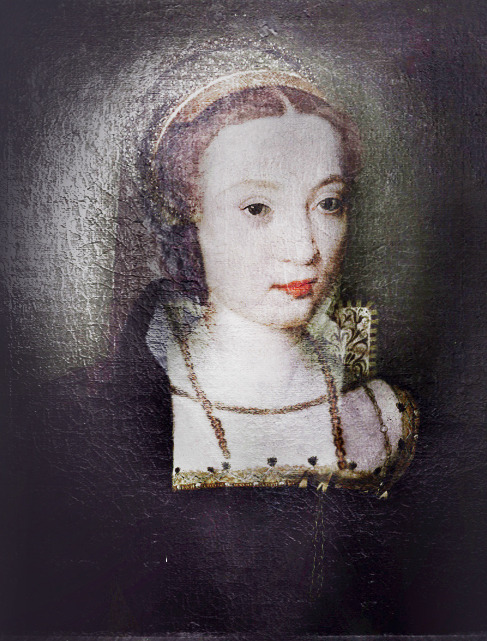
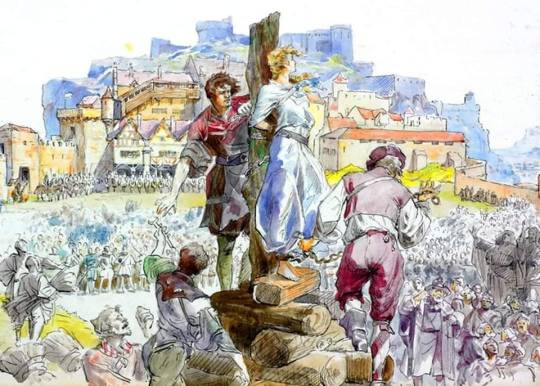
On July 17th 1537 Janet, Countess of Glamis was burnt at the stake on Edinburgh's Castlehill after being found guilty of two counts of treason.
Lady Glamis was the sister of Archibald Douglas, sixth Earl of Angus, who became the second husband of the Scottish Queen Dowager, Margaret Tudor, in 1514.
After James IV, had been killed at the battle of Flodden in 1513 his mother Margaret subsequently ruled Scotland as regent. She remarried and the ole of her new husband, the Earl of Angus, caused resentment among the Scottish nobility so much so John Stewart, Duke of Albany, was proclaimed replacement regent in 1517.
The on-going feuds between the Stewart and Douglas clans would heavily influence James V, who came of age in 1528 and sought to assert his influence on his kingdom. He was brieflyheld aptive by Angus as a young child in his attemptto control the country, thisis said to have deeply affected the young King.
His anger and desire for revenge later became centred on Janet Douglas. When her husband died, she was left without a protector.
James V accused her of poisoning her first husband, John Lyon, sixth Lord Glamis, when he died in 1528. She was however acquitted and remarried Archibald Campbell in 1532, after ceasing all communication with the Douglas clan in order to try and prove her innocence to James V.
This peace was not long lasting and five years later James once again accused her of attempting to poison him and also of conspiring with the Douglas clan against him.
These accusations of treason and witchcraft were ungrounded. To combat the lack of proof for these heavy claims, James managed to gather evidence against Lady Janet by torturing her family and servants to the point of extracting false evidence and statements against her nature. It is said that her young son was forced to watch his servants and family being tortured, before being tortured himself on the rack.
The rack was an implement of torture and was used to ‘stretch’ victims to the point of excruciating pain by tying their ankles and wrists separately and pulling them in opposite directions.
Lady Janet was subsequently burned at the stake at Edinburgh Castle, where allegedly her son was forced to watch her burn before he was released. It is said the onlookers watched in silence, tears in their eyes.
Lady Janet is said to roam the halls of Glamis Castle… she has been seen wandering the halls, kneeling in front of the alter praying in the chapel and above the clock tower.
Apparently, when in the chapel of the castle, people are overcome with a feeling of immense sadness and desolation. A seat is constantly kept empty for Lady Janet in the chapel, and it is said one hundred witnesses once saw her glide past them in the chapel, heading towards her allocated seat.
Lady Janet Douglas of Glamis is remembered as one of the most tragic figures in our history.
33 notes
·
View notes
Note
It is said Elizabeth Woodville retired to Bermondsey Abbey 1487? Did she live humbly at the time of death?
Hi! To get straight to the point - we don't actually know when Elizabeth Woodville took up residence at Bermondsey Abbey. It is popularly claimed by most historians, including her own, that she moved there in 1487, but there is no actual historical evidence to support this date. According to J.L. Laynesmith's newer research, "this tradition [may have arisen] from confusion with the date of the council that Vergil said was the occasion on which her estates were resumed." In reality, Elizabeth could have moved into the abbey in 1487, or sometime in the subsequent years, or close to her death when she was ill and may have wanted to seek treatment. We just don't know.
I'm also personally hesitant to claim that Elizabeth was "retiring", because I'm not quite sure what she was supposed to retire from. For one, as the dowager queen who was mother to the queen consort rather than the King, her position was very anomalous and entirely unique, especially since the King's own mother, Margaret Beaufort, was alive and active. Elizabeth was not stepping back from any role she could have otherwise played, because there was no role or precedent for her to play in the first place; no post-Norman queen had been in a position like this before. Secondly, while several dowager queens and noblewomen had the option of managing their estates during their widowhoods, we know that Elizabeth's dower lands had been transferred to her daughter in May 1487*. So, considering she lacked both options traditionally available to dower queens (the role of king's mother and major landowner), there was really nothing that Elizabeth could have actively been "retiring" from. Her residence in Bermondsey could have been a retreat of some kind...or could have been a pragmatic living arrangement, a way to give her daughter space to establish herself as England's new queen, or simply a desire for an alternate residence that gave her some privacy when required. Or something else altogether. Once again, it's unclear.
(It's clear that Elizabeth would have had a visibly powerful and direct role in governance during her own son's minority and reign, as described here).
We also don't even know if Elizabeth resided in Bermondsey Abbey permanently. For example, in July 1486, we know she leased a mansion within Westminster Abbey called 'Cheyne gate'. Arlene Okerlund believes this is proof of her religious commitment and desire for seclusion, but as Susan Higginbotham pointed out, Elizabeth could have simply been "interested in obtaining a residence convenient to the court when it was at Westminster". We don't know if Elizabeth ever even stayed at this residence, and if she did, we know for a fact that it was temporary, because she ended her life in an entirely different abbey. In my opinion, the same logic and same questions can and should be applied to Elizabeth's stay in Bermondsey. It's entirely possible she had other residences she was living in, or even a place at court, that we simply don't know about, due to a lack of surviving evidence and/or a lack of sufficient research.
What I want to point out is that Elizabeth very much was present for at least some court occasions in the years after 1485. She took a central role in the christening of the dynasty's new heir, Arthur, standing as his godmother and presenting him with a 'rich cup of gold'. (She took precedence over king's relatives, including his mother Margaret Beaufort, who doesn't even seem to have been present for the occasion). She was present during her daughter's childbirth confinement and received the Luxemburg delegation. She was also recorded attending mass and receiving papal envoys along with her daughter, son-in-law and Margaret Beaufort in 1489. We also know that Elizabeth was considered as a potential wife for James III of Scotland, which would enable her to possibly again take up the role of queen consort once again, though his death in June 1488 prevented this from potentially materializing (it was by no means guaranteed, though*). So, whether or not she was residing in an abbey or somewhere else or alternating between different residences, it's clear that Elizabeth remained firmly connected to court. She may have been with the royal family on other unrecorded occasions, such as the time when Henry VII ordered the Exchequer to pay her some money "by way of reward for a tun of wine" in 1488 from Windsor Castle. We don't know - but the possibility is very much there.
This is getting into more speculative territory, but another thing to point out is that according to the Colchester journal, Elizabeth had originally petitioned parliament for restoration of her “castells and oder possessions that she was possessed of in King Edward’s day" in 1485. According to Lynda Pidgeon, this was initially turned down, although it was later confirmed that she ‘shall have and enjoy henceforth all such estate, dignity, pre-eminence and name as she should or might have had or done if no act of parliament had been made against or concerning her in the time of Richard III'. It seems to me that Elizabeth may have originally had very different intentions and expectations for her widowhood: she seems to have initially wanted to retain her own lands and administer her estates by herself, which was her right as dowager queen. It suggests that her priorities may have either changed over the years or were forced to change due to external circumstances (the financial constraints in the early years of Henry VII's reign, Simnel rebellion in 1487 which threatened her family, etc). It's unclear.
Lastly, it's often claimed that Elizabeth had "cultivated a lifestyle of comparative simplicity" (Laynesmith) by the time of her death. While we don't know this for sure, I think it's very plausible: she explicitly specified she owned very few goods in 1492, requested for a modest funeral that surprised the herald recording it, and wrote a very short and simple will in contrast to the elaborate ones of, say, Margaret Beaufort and Cecily Neville. But if this is true, we don't actually know when Elizabeth's decision for such a lifestyle came about, let alone what actually prompted it. Was it directly after 1485 (very unlikely, based on what I mentioned above regarding her petition)? Was it over the years due to now-unknown reasons? Or was it simply because Elizabeth was nearing her death, and this was her way of expressing acceptance/closure/penance? Once again, we simply don't know. There could be other reasons for her requesting a simple funeral as well - if she truly died of the plague (which seems likely), she may have wanted to avoid exposing her family to contagion. We can't presume to know her motivations.
Obviously, I dislike the popular idea that Elizabeth plotted against Henry VII and her own daughter and was subsequently banished for it. (This isn't limited to Yorkists/Ricardians but the vast majority of general histories, the vast majority Tudor historians - including ones I admire greatly like Lucy Wooding - and the most academic of Elizabeth's own biographies till date***). But I equally dislike the revisionist interpretation that she entered into a "quiet retirement" or "relative seclusion" post-1487 that Arlene Okerlund and the latest Fifteenth Century XX book are so keen to propagate, usually with exaggerated claims that she was "beyond conventionally religious" (there is no evidence of this). Like I said, we don't know when Elizabeth began residing in Bermondsey, we don't know why, and we don't know if it can even be called a "retirement". It's as much a stereotypical interpretation as the vilified one, and ultimately contributes to the exact same narrative - Elizabeth is conveniently shoved or nudged out of the way, forgotten and irrelevant until her death in 1492. It's just so disingenuous when you keep in mind that she initially wished to administer her estates and that she remained connected to the court. This is aided by the fact that analyses of Elizabeth during this time almost always focus on Henry VII and his circumstances rather than her circumstances or what she might have thought or wanted (see: her unique role as queen who was mother of the queen who lacked estates, etc), and it's...incredibly frustrating. I think historians just need to get comfortable admitting that we know significantly less about Elizabeth's life than we think, and that what we do know is incredibly haphazard and can't really be used to form definite conclusions on most things. Analyses of all aspects of her career have been hindered by their utter unwillingness to acknowledge this.
*We don't know what Elizabeth felt about the transfer of her estates, or her proposed marriage to James III, or the annuity she received from Henry (which was initially lesser than the 700 marks she received from Richard III in 1484, despite her degraded status from queen to the king's concubine with illegitimate children during Richard's reign, though it was also very understandable given the financial difficulties in Henry VII's early years). She may have agreed to them, she may have been prompted/pressured to agree by circumstances or by others, or she may have suggested/initiated some of these things herself. We do know, however, that she remained close to Elizabeth of York and appointed her as supervisor of her will when she died – so I personally think she would have wanted to support her daughter. At the very least, interpretations should keep their closeness in mind. **According to David Baldwin, the proposed marriage was supposedly mooted as early as 1486, before the Simnel Rebellion. The sources he provides are: Rotuli Scotiae, ed. D. Macpherson et al., 2 vols. (1814–19), ii, pp. 475–7. ***Beyond this one instance, I find it incredibly frustrating and ignorant/disingenuous in general when people try to downplay how widespread Elizabeth's negative image really is by claiming it's "only" propagated by the Yorkist/Ricardian community. I can assure you it's far more widespread than that and is used by most general/popular histories and historical fiction of the 15th century, regardless of which "side" they're on (also, there's an assumption that because most Ricardians hate Elizabeth, the opposite is true and that criticisms of Richard lead to sympathy for Elizabeth; but the reality is that the vast majority of histories and fictional works that critique Richard are equally critical of the Woodvilles). That's not even getting into how there are literally no actual reassessments on pretty much all important and controversial aspects of Elizabeth's life till date: her position as the first post-Norman Englishwoman to be crowned queen and what that actually meant for her on practical terms, her family's role in the factional conflict/divide in the 1460s (revisionist histories pretty much always dismiss it outright, which makes no sense as it very much happened and needs to be properly explored and dealt with rather than ignored), her highly unconventional position in royal councils, her role in 1483, the propaganda against her and the many unprecedented official accusations levelled against her, etc. As I said before, there is very lacking academic interest in Elizabeth's individual life beyond the bare basics, be it in popular vilified interpretations or more limited "revisionist" histories. That's completely fine, no one needs to or should should force themselves to study her, but people have got to stop simultaneously pretending that she has been adequately reassessed when she very much hasn't been. (ie: you can't "debunk" something you haven't even acknowledged in the first place, lol). Nothing that has been written about Elizabeth till date has ever come close to the excellent and genuinely revisionist analyses that have explored and/or vindicated several other "controversial" post-Norman queens of England (Empress Matilda, Eleanor of Aquitaine, Isabella of France, Margaret of Anjou, Anne Boleyn, etc) sans only Isabella of Angouleme. People need to stop claiming the opposite and start acknowledging reality.
#ask#elizabeth woodville#15th century#english history#sorry ik I ranted a bit at the end but it's just annoying when people misunderstand the level of research we're actually at wrt EW#it's a whole lot of words and very lacking substance#henry vii#(because it's during his reign)#my post
9 notes
·
View notes
Text
Sixteenth-century Scottish lords, in response to any political problem: We have a plan!
The dowager queen of Scotland: Does it involve kidnapping, violent murder, or placing a baby on the throne?
The Scottish lords:
The Scottish lords: We no longer have a plan.
26 notes
·
View notes
Text

BRIDGERTON STARTER CALL!!
i'm living my best regency life rn so like this for a randomised starter from one of these muses. connections will likely be pre established and shipping may occur. only like this if you're okay with that.
muses are below... some are canon, others have their own verses.
Alice Crawley / sister of Earl Grantham, ages with Francesca.
Anne Boleyn / loyal lady in waiting to the Queen.
Anthony Bridgerton / canon.
Arthur Fitz-Clarence / newly inherited Duke of Oxford.
Catherine Gordon / Countess of Huntly in her own right, Scottish.
Daphne Bridgerton / canon.
Henry Talbot / father is a member of parliament, nephew of Dowager Baroness Shackleton.
Richard, Duke of Gloucester / nephew of the King.
Robert Bruce / King of Scotland, godson of the Queen.
Sherlock Holmes / advisor for the royal family.
Thomas Barrow / Butler for the Bridgertons.
#indie bridgerton rp#indie period rp#indie period drama rp#indie history rp#indie historical rp#👑 𝐎𝐎𝐂 ——— starter call.
19 notes
·
View notes
Text






A happier life for Henry VIII's children: Part 3.
Edward was the son of King Henry VIII of England and his third wife Jane Seymour. The birth of a healthy boy was a great miracle and joy not only for his father, but for the whole of England. Edward's childhood was happy, because he had his own mother with him, who with her gentle voice could calm and support him. But it did not last long, in 1547 the boy had to grow up sharply and take on his children's shoulders the responsibility for the whole country, because his father Henry VIII died. His older sister Mary, Queen of France, became regent until the little king came of age. Mary ruled in her brother's place for 8 years. In addition, Mary and Jane did not allow the latter's brothers to influence the young king. Edward and Thomas Seymour were angry about this and they even tried to remove Mary from power, but they failed. The Queen of France uncovered the plot and sent them both to the Tower for life. In 1557 Mary's regency ended and she returned to France, and Edward became the rightful ruler of his state. Two years earlier the king had become interested in Protestantism, and secretly from his mother and sister he began to study it. At a council, he told his lords that he wished all England to convert to this religion, and most of his advisors supported his idea. The Queen Dowager of England tried several times to dissuade her son, but he became angry and made it clear that he would not allow her to interfere in his affairs of state. Queen Mary of France also did not lag behind and tried to return her brother to Catholicism and her attempts were not successful. But there were also those who disagreed, and because of this there were riots and rebellions in the country, the rioters demanded that the king left his venture and returned to the true faith. However, the king was not deterred by their demands, Edward managed to quell the rebellions and to appease his subjects, he declared in public that he would be tolerant and let them believe what they wanted. And to reconcile Catholics and Protestants, Edward promised to marry a Catholic princess, but their children would be Protestants, and to marry his other older sister Elizabeth to a Protestant. In 1558, the princess married the eldest son of the King of Sweden and left England for good. The king himself married Mary Stuart a year later. The marriage between the King of England and the Scottish Queen was a very successful and cohesive one. Mary appointed her consort as her companion and they lived on two countries.
Jane of England(1560 - 1618). Duchess of Angoulême. In 1578 she married her cousin Charles. Their married life was not a happy one. After the birth of their last child, the couple finally drifted apart and stopped living together. Four children were born in the marriage.
Henry IX of England(1561 - 1611). King of England, Ireland and Scotland. In 1589 he became King of England, and in 1600 of Scotland. In 1605 he proclaimed himself king of Great Britain. He was married, but did not love his wife, during their marriage he never touched her. Also the king had a mistress who bore him 5 children out of wedlock: Mary, Edward, Elizabeth, Grace and James. Died at the age of 51 of bubonic plague.
James I of England(1563 - 1627). King of Great Britain. Inherited from his older brother, as the latter had no legitimate children. Also, unlike Henry, he loved his wife and never cheated on her. Husband of Elizabeth of Denmark, father of 11 children: Edward VII, Sophia, Charles, George, Isabella, Joan, Frederick, Barbara, Henrietta, Arabella and Robert.
Mary of England(1564 - 1590). Mary was given in marriage to her cousin at the age of 18. The marriage produced 4 children. In 1590, Mary contracted pneumonia and died on the anniversary of her father's death.
Elizabeth of England(1567 - 1570). In 1570, the princess caught cold, contracted pneumonia and died at the age of 3.
Margaret of England(1569 - 1624). She was married twice, but both her husbands died shortly after the marriage. After the death of her second husband, Margaret declared that she would never marry again. She founded a charitable foundation and helped anyone in need, she especially focused on helping women and children.
Edward of England(1572 - 1586). Duke of Somerset and Albany. From birth had poor health. Died at the age of 14 from smallpox.
Richard of England(1575 - 1655). Duke of Somerset and Albany. After the death of his brother in 1586 all his titles passed to him. The Prince was noted for his good health and poetic ability. During his lifetime he became a famous poet. In 1600 he married Elizabeth Howard, after the wedding Richard and Elizabeth removed from the court and began to live a happy and quiet family life. The marriage produced 7 children: Mary, William, Edward, Philip, Anne, Catherine, and Nicholas.
Jane Seymour loved her daughter-in-law as her own daughter, the dowager queen liked to spend time in the circle of her grandchildren. On her son, she had almost no influence, but the king loved his mother and because of respect sometimes listened to her advice. Jane died in 1565, and Edward was greatly grieved by her death. Mary, more than anyone else, understood how her brother felt and despite their differences on matters of religion, came to England to give him moral support. In the end, they finally reconciled. Edward VI was a king beloved by the nobility and the people. For most of his reign, he tried to try on Catholics and Protestants and prevent religious warfare within the country. On top of that, the king gave shelter and protection to Protestants who had fled religious persecution. Edward VI died of tuberculosis in 1589. He was buried in Westminster Abbey next to his parents and other family members. Eleven years later, his wife Mary Stuart was buried next to him.
#english history#history#royal family#royalty#history au#au#royal#henryviii#the tudors#16th century#british royal family#edwardvi#marytudor#mary stuart#anne boleyn#catherine of aragon#elizabethi#elizabeth tudor#jane seymour
15 notes
·
View notes
Text
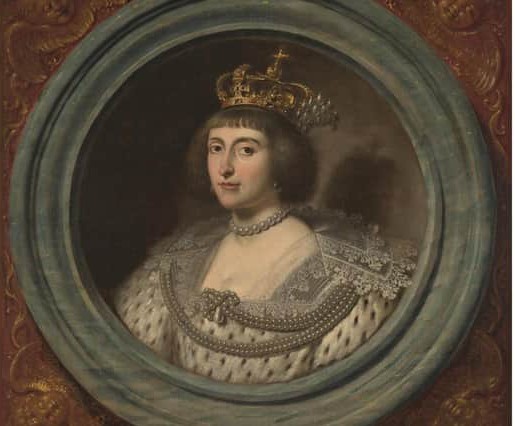
[The portrait] shows Elizabeth, daughter of King James VI and I and elder sister to Charles I, wearing an ermine robe and crown. [Jan] Peeters believed that the crown – added to an earlier painting by a second artist – was the same one that had been lost by Charles I during the Civil Wars, broken up and sold for scrap by parliament. This crown, the so-called Tudor Crown, was the crown of England.
...[W]hen Thomas Howard, 4th Duke of Norfolk, was put on trial in 1572 for plotting to usurp Elizabeth I with Mary, Queen of Scots, her gift to him of an embroidered cushion was exhibit one. The needlepoint image of a blade cutting a barren tree branch to allow new roots to spring was enough to lose him his head. Mary, of course, damned herself in writing, but in a society that accorded such importance to visual rhetoric, it is hard to believe that the portrait of Elizabeth Stuart that comprised no mere emblem, but a contender blatantly wearing the crown, could not be taken as evidence of treason.
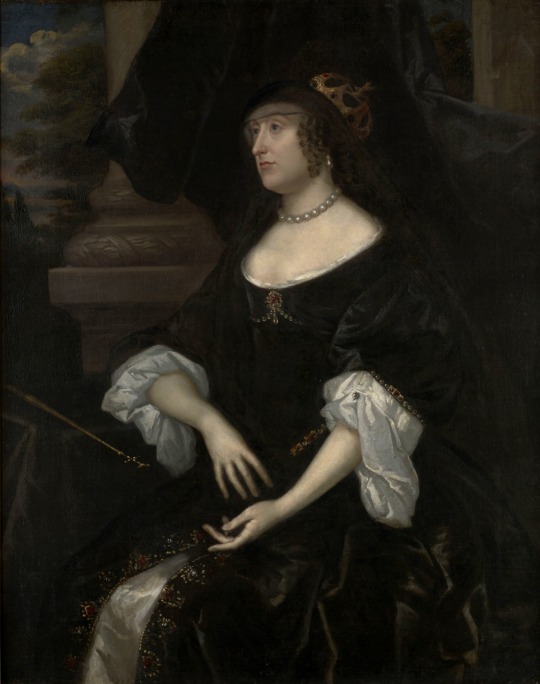
Elizabeth in her own crown as Dowager Queen of Bohemia
In 1623, Charles and his court favourite, the Duke of Buckingham, made the perilous – and ultimately fruitless – journey to Madrid.... [T]he Venetian ambassador in England, Alvise Vallaresso, advised his superiors that if Charles were to die en route, Elizabeth would become heir. He added that, when compared to the prince, she was “physically nearer this people and certainly much nearer their hearts”. Elizabeth’s popularity resulted from her militant Protestantism and her fearlessness. She was skilled with bow and arquebus (a type of long gun), she hunted regularly, spearing boars from horseback even when pregnant. Such was her charisma that even Scottish Catholics were drawn to her cause.
...
Painted almost a century before George [I]'s coronation, the portrait of Elizabeth wearing the Tudor Crown was indeed potentially treasonous. Though it was most likely meant not to be widely viewed, it made concrete a long-standing feeling that Elizabeth was the warrior queen that England, Scotland and Europe’s Protestants truly craved during the century’s darkest times.
23 notes
·
View notes
Text






𝑰𝒏𝒕𝒆𝒓𝒏𝒂𝒕𝒊𝒐𝒏𝒂𝒍 𝑹𝒐𝒚𝒂𝒍/𝑰𝒎𝒑𝒆𝒓𝒊𝒂𝒍 𝑯𝒊𝒔𝒕𝒐𝒓𝒚 𝑨𝒑𝒑𝒓𝒆𝒄𝒊𝒂𝒕𝒊𝒐𝒏 𝑴𝒐𝒏𝒕𝒉:
𝑾𝒆𝒆𝒌 1:𝑸𝒖𝒆𝒆𝒏/𝑬𝒎𝒑𝒓𝒆𝒔𝒔 𝑫𝒐𝒘𝒂𝒈𝒆𝒓𝒔
𝑫𝒂𝒚 2: 𝑴𝒂𝒓𝒈𝒂𝒓𝒆𝒕 𝑻𝒖𝒅𝒐𝒓, 𝑸𝒖𝒆𝒆𝒏 𝑫𝒐𝒘𝒂𝒈𝒆𝒓 𝒐𝒇 𝑺𝒄𝒐𝒕𝒍𝒂𝒏𝒅
#mary tudor#queen dowager of scotland#the spanish princess#international royal/imperial history appreciation month:week 1
6 notes
·
View notes
Text


THE KING'S SISTERS
Margaret and Mary, Princesses of England, were daughters of Henry VII, King of England, and Elizabeth of York, Queen of England, making them the sisters of Arthur Prince of Wales and Henry VIII, King of England. Margaret became the Queen Consort of Scotland by her first marriage to James IV of Scotland, becoming Dowager Queen of Scotland after his death and at times Queen Regent of Scotland on behalf of their son James V, King of Scotland their only child to reach adulthood. On the occasion of her second marriage to Archibald Douglas, Earl of Angus she became the Countess of Angus, they had one child Margaret Douglas who grew up in the court of her brother, Margaret's marriage to Angus ended in divorce which Margaret instigated and successfully obtained at the astonishment of courts abroad including her own brothers. By her third marriage to Henry Stewart, Lord Methven she became Lady Methven no issue came of this union. Through her son, she became the grandmother of Mary I, Queen of Scotland commonly known as Mary, Queen of Scots who was later executed by her niece Elizabeth I of England. Through her daughter, she was the grandmother of Henry Stuart, Lord Darnley and Charles Stuart, Earl of Lennox. She was the great-grandmother twice over of James VI of Scotland and I of England making her the ancestress of all monarchs of England and then Great Britain. Mary became the Queen Consort of France by her first marriage to Louis XII of France, their marriage only lasted two months and three weeks (shorter than any of her brothers' marriages) with the sudden death of her husband, she then became Dowager Queen of France no issue came from this union. Her second marriage was to Charles Brandon, Duke of Suffolk making her the Duchess of Suffolk, their marriage caused quite a stir as Henry wanted to arrange another marriage of alliance for her and Henry's court did not want to grant more power to her husband. They later married a second time in the presence of her brother once welcomed back in her brother's court. They were married for eighteen years and she often took her husband's side on major issues of Henry's reign including being outspoken against his want and later marriage to Anne Boleyn, as well as Anne's character and actions. Her marriage to Charles produced four children with two daughters reaching adulthood Frances and Eleanor. Per the Act of Succession 1536 (three years after her death), her heirs took precedence over her elder sisters and were next in line to the English throne after her brothers. Through Frances Mary was the grandmother of Jane Grey, Queen Regnant of England who was made the heir of Edward VI over his sisters, Jane was later executed by Mary's niece Mary I of England. Mary's other Grey granddaughters Catherine and Mary also were points of contention during Elizabeth I's reign.
[As portrayed by Georgie Henley and Sai Bennett in Starz The Spanish Princess]
#the spanish princess#thespanishprincessedit#perioddramaedit#georgie henley#sai bennett#margaret tudor#mary rose tudor#mary tudor#my edits
41 notes
·
View notes
Text

The Accused - Mini Plot Drop 2
With the interrogations underway and weeks counting down until The Tribunal begins, an official dossier of the criminals accused has been released to the public. Up until this point, the criminals at hand had yet to be linked to their specific crimes. However, through the determination of litigators for the upcoming Tribunal, the below information has been uncovered:
Duke Gabriel Cuvelier (from France) - Age 62, former advisor to the French King, accused of ordering the hits against The King of Ethiopia & both Scottish rulers (and personally funding the assassinations). Refuses to give any information other than the simple statement - “It is not yet over.”
Duchess Adele Cuvelier (from France) - Age 59, wife to Duke Gabriel, Close comrade and confidante of Prime Minister Nicolette. suspected of being the lead organizer of the reckoning attack at lal qila. May be responsible for a number of ordered hits.
Apolline Lefrancois (from France/now Florence) - Age 30, former lady-in-waiting to the Queen of France until marrying years ago & moving to Florence, suspected of being the assassin responsible for the death of the Dowager Queen of Ethiopia. Her husband cannot be located & their Florence residency seems abandoned, though signs show that the King of Norway (oldenburg) may have been held there for a time.
Sabino Montez (from unknown/believed to be Spain) - Age 55, a new cook for the royal Ortiz court, arrested upon arrival in Brazil. Accused of the poisoning & murder of Queen Martina Bonaparte, evidence of correspondence with both French & German rebellion leaders, and evidence of involvement in the reckoning. Is a known loyalist of the Ortiz reign and has been suggested to have ties with the French rebellion leaders.
Takuda Toshiko (from Japan/Hong Kong) - Age 32, distant cousin to Emperor Kaito, suspected of involvement in the assassination of the former German King (pre-Elias reign), believed to be the assassin. Former resident of Hong Kong and known dinner guest of the Viceregal. Evidence points to a spy in the Japanese court still working for Takuda due to recent correspondence written in extensive code from the Toshiko court.
Madhavan Parkash (from India) - Age 40, former financial advisor to the Empresses of India, evidence romantically links them to 1 or more of the Empress’ lovers, suspected to have been behind the poisoning of the Sharma line. Possible involvement in the attack on Thailand’s heirs based on correspondence with Madagascar.
Rishabh Sundar (from India) - Age 29, evidence found to associate them with Takuda Toshiko, believed they are in a relationship. Suspected involvement in the attacks on Germany, may have been involved in the German Tribunal tampering with evidence.
Peter Herrmann (from Germany and/or Scotland) - Age 51, former groundskeeper for the Stuart's in Scotland, had been working in Germany once more before the attack on the Scottish rulers, evidence suggests they were largely involved in the reckoning. Likely to have been involved in both Scotland’s & Germany’s tragedies.
Lao Patalung (From Thailand/now Madagascar possibly): Age 62, former governess to the Thai King & sibling as children. New evidence places them as the last person to visit the deceased heir’s nursery before their untimely passing. Recent ledgers show payments from the Rakotoson’s accounts into their personal accounts, and evidence supports their residency in Madagascar for the last year.
Pascal Rakotoson (From Madagascar): Age 43, Former royal advisor to King Mendrika & the Ratsifi family until banished for the misuse of the royal bank. Since their banishment, Pascal was sighted in both Thailand and Japan courts at the time of attack on their royal families, and is believed to be involved in both.
Kaiden Nelson (From Cardiff): Age 22, soldier for the Scottish army and trained under Commander Cailean for a time. Has since turned into the “golden boy” of the Scottish rebellion. Evidence found of large sums paid to foreign mercenaries, tied directly to the death of the King and Queen of Scotland.
Meryem Aydin (From Turkey/now China): Age 68, Long-time mistress to the former Sultan of Turkey (pre-Rahmi’s reign) and figurehead of Turkish court. Disappeared shortly after Rahmi’s trial began, only to reinvent herself under a false name in Chinese court. Confessed to falsifying evidence against Shah Khan of Persia to spearhead the order of his death. However, her confession appears too convenient to be trusted.
While some mysteries remain, including why they had gathered in Russia & what they were planning there, the information in the report is generally considered to be believed, though some may know that not all accusations are true…
OOC INFO
Feel free to headcanon connections your characters have to the npcs, but please just let the admin team know of any significant connection so it be used for future drops!
If you want to be included in a larger plot, have any ideas for the npcs, or want to discuss ideas on mini plot drops related to new, member-driven information, reach out and let’s talk!
If your character has a secret related to the reckoning you want to play with or have revealed, please reach out so we can link an npc to your character. We are very open to suggestions for progression if you have ideas!
As always, these mini plot drops are entirely designed to be interacted with at your own pace! If your character is not politically inclined nor following closely the tribunal, that is perfectly fine! This is purely to provide character building & contextual information for those who enjoy this type of gameplay.
Enjoy!
6 notes
·
View notes
Text
task 001 - the interrogation // commander a. hasan

(Hello, can you please tell me your name, country, && what role you provide your court?) it had come out of left field, a summons; another invitation to something that wasn't quite what everybody expected by the mughal empire. "kabir," abdullah leans forward in his seat, his face inches from the interviewer's, a flush of stoicism and danger lingering in his face. "it will do you well to come out with it, son, who put you up to this?" silence passes, abdullah grows irritated but concedes with a sigh. "commander abdullah hasan, field marshal - india."
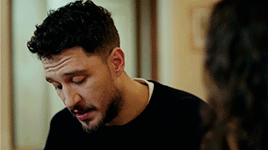
( And who do you believe to be your closest allies, either nations or individuals? Do you trust your allies?) he shifts. "allies become enemies in the wake of great tragedy. at one point or another, i was under the impression that tragedy would bring us together - this event has showed me otherwise." a lie; he had never been under the impression that tragedy did more than stir up the anger in the world. "eesha - i trust her. that's it."

( Ah, yes, I see... how about your enemies, then. Who do you not align yourself with, and why?) "ethiopia." it's an immediate answer but his explanation isn't nearly as specific. "rats run rampant there. did you know? and i have a feeling that they are in this palace as we speak, festering, breeding their disease in our halls." the commander leans their spine into the chair. "scotland." another immediate answer. "their king departed in the middle of a memoriam - could his conscious feel guilt for the misery that his hands have caused?"

( Interesting. Do you have a personal vendetta against any of the courts, or even individuals, here?) "the persian sultan's husband did compare me to a camel once, a hardy comment from a man who was cas-" he stops himself, trying to withhold a grin. "no."

( What are your thoughts on the mysterious deaths in so many royal families?) "kabir, we have spoken many times about this. you know my opinion of it - they targeted the wrong leaders - the emperor of japan? his wife? the king of germany? the sultan of persia? the dowager queen of ethiopia? from what i know of them, they were good people, innocent despite their faults - i think somebody got it wrong and they'll pay for it, greatly."

( How do you feel about the system of monarchy as a whole?) "blood breeds the problems we face. monarchy is not the problem, son, the line of inheritance is. some families are plagued with a sickness of the mind so difficult to notice that it has become normalcy. there is no reason, no thought into who leads us - merely son after son after son until somebody revolts and takes it for themselves - thus the cycle of self-importance starts again with a new bloodline."

( So, what would be your best theory as to what is going on, then?) "for the time being theories evade me, however, the only thing that is clear is that somebody powerful is the cause. to have your hands in so many kingdoms? that kind of reach is not attained by chance. they did this on purpose. that's my deduction."

( Thank you for your time. Is there anything else you'd like to add, anything else that would be useful to the investigation?) he ponders it for a moment, a sly grin upturns devilishly at the corners of his mouth as he goes to stand. a dangerous hums falls from his lips, his hand pats the interviewer's cheek. "no, sir, however - in regards to your investigation into your wife's affair, well, just know that she was very well taken care of, all four times. have a good afternoon."
#c: commander abdullah#theopulent.task#listen while reading the prompt abby was all up in my head#cheating tw#infidelity tw#t: the interrogations#s: the interrogations#act I: lal qila
5 notes
·
View notes
Text


Authors Toby Marlow and Lucy Moss found inspiration for their hit musical in the lives and loves of King Henry VIII, but SIX tells the story from the women’s point of view.
Each queen gets her moment in the spotlight to explain her fate of being “Divorced. Beheaded. Died. Divorced. Beheaded. Survived.”
Divorced: Catherine of Aragon
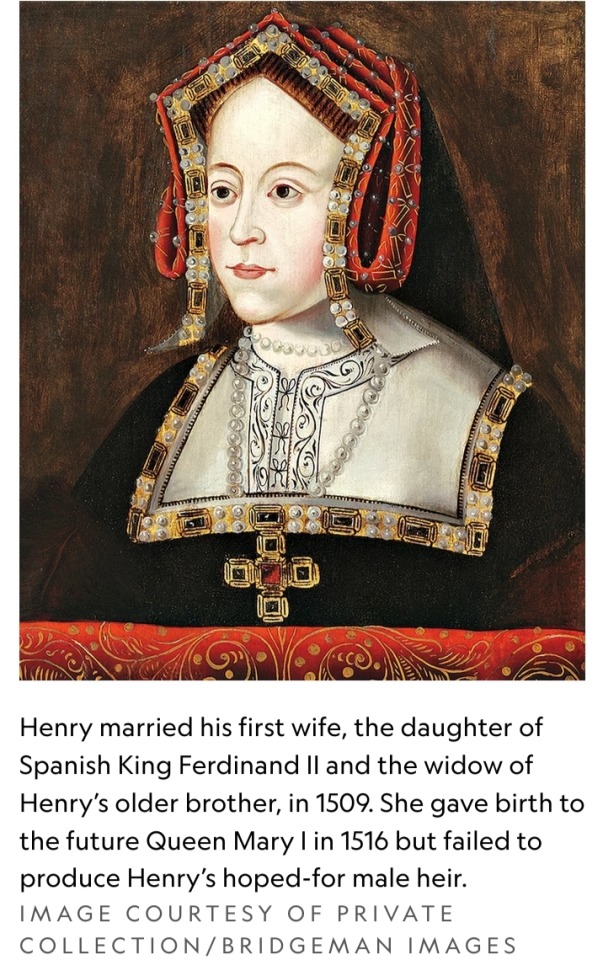
Larger-than-life Henry VIII ruled England for 36 years (1509-1547), raging war against France and Scotland, separating from the Catholic Church, and paving the way for the constitution of England, among other political achievements.
But young Prince Henry was not destined to be king. When his older brother Arthur died in 1502 at age 15, Henry became the heir to the throne.
When Arthur died, Henry didn’t just inherit the throne—he inherited his brother’s fiancée, Catherine of Aragon.
After marrying, the two became parents to a son—who tragically died two months later.
Their daughter Mary was born in 1516, but by 1526, the marriage had not produced the male heir Henry needed to secure the succession.
He began looking for a new bride, even though the Catholic Church made it impossible to divorce Catherine.
In the end, the answer was simple:
Henry believed he was a king ordained by God, so he, not the pope, had ultimate authority over his kingdom; as such, he could grant his own annulment.
This decision led to England’s break with the Catholic Church—and the creation of the Anglican Church.
After their annulment, Catherine was given the title “Dowager Duchess of Wales,” and she lived out her days at Kimbolton Castle. She died in 1536 from cancer at the age of 50.
Mary, by the way, went on to become Queen of England and Ireland from 1553 to 1558, during which time she fought to reverse the English Reformation, brought about during her father’s reign.
Beheaded: Anne Boleyn
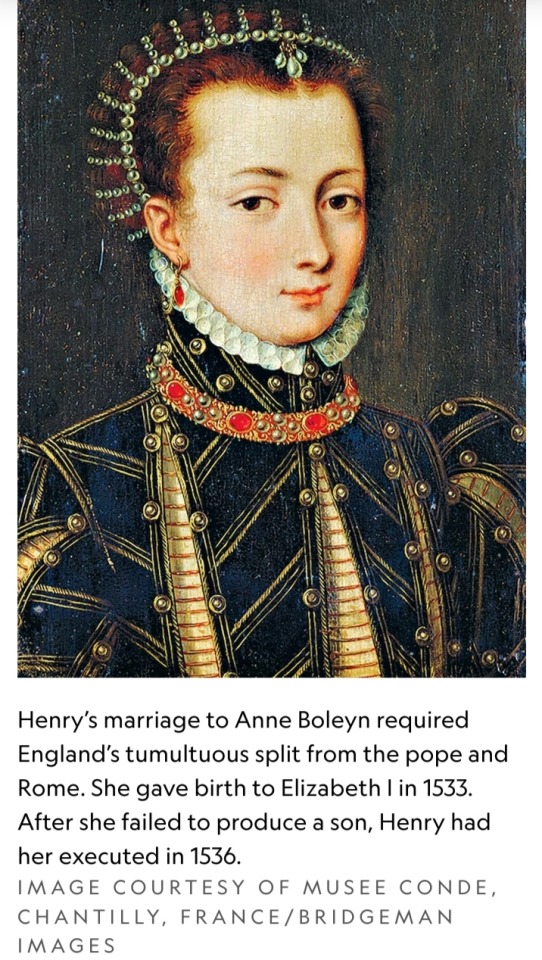
While still married to Catherine, Henry had begun wooing a court beauty, Anne Boleyn, and was determined to marry her.
A lady-in-waiting to Catherine, Anne was sophisticated, charming, and confident.
She is commonly believed to be the wife he loved the most.
As his advisers worked on “the King’s great matter” of the divorce, the couple had to wait seven years to be married—though the two flaunted their relationship in court.
He wrote her love letters, which still exist today:
“I hope soon to see you again,” he wrote, “which will be to me a greater comfort than all the precious jewels in the world.”
Anne was six months pregnant when they finally said “I do” in June 1533. Three months later, she gave birth to Elizabeth I.
She had two stillborn children and suffered a miscarriage in 1536; the fetus appeared to be male. Henry still did not have his heir.
Little by little, Henry grew tired of Anne, and his eye caught sight of a new woman: Jane Seymour.
To end the marriage, Henry needed to find a way out—and he found it through accusing Anne of high treason.
For the crimes of adultery, incest and plotting to murder the king, Anne was arrested and imprisoned in the Tower of London.
She went on trial, denied all charges, but was found guilty.
Anne was beheaded on 17 May 1536 at the Tower and buried in an unmarked grave beneath the Parish Church there.
Died: Jane Seymour

While married to Anne, Henry visited the Seymour home. It was believed that was when he first laid eyes on Jane, who served as a lady in waiting for both Catherine of Aragon and Anne Boleyn.
As in his relationship with Anne, Henry began courting Jane while still a married man.
Beautiful and reserved, she was a stark contrast to his first two wives. Before long, rumors of his attraction to her spread.
He proposed to her the day after Anne Boleyn’s execution, and they were married a month later.
She bore a son, the future Edward VI, in 1537 but died within 12 days of giving birth.
She is the only wife buried with him in the same tomb in St. George’s Chapel at Windsor Castle.
Divorced: Anne of Cleves
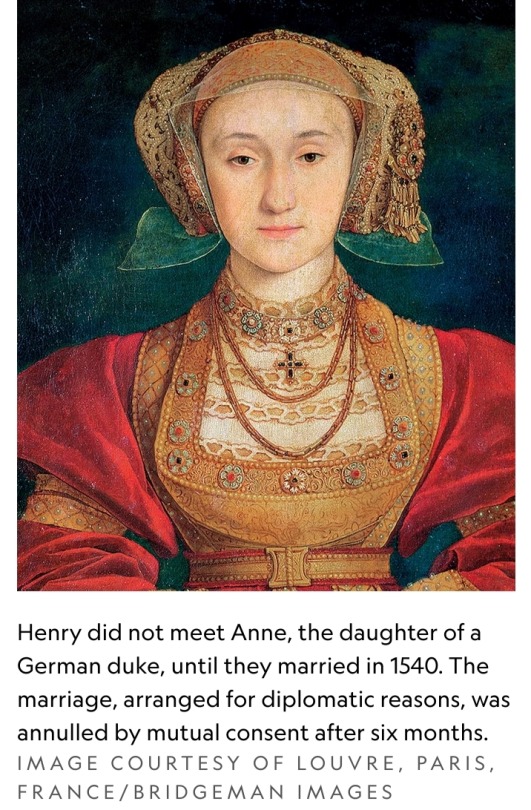
Henry’s ministers searched high and low for a new wife for the king, whose abysmal marital reputation preceded him.
Anne of Cleves, the daughter of a German duke, became a prospect for diplomatic reasons:
The marriage would ally England with a Protestant duchy, thus solidifying England’s religious reformation.
But Henry needed to know what she looked like, so, on the advice of Thomas Cromwell, he sent his favorite court painter, Hans Holbein the Younger, to the German duchy.
He approved based on the portrait.
When Anne arrived, however, he was crestfallen to see she was not as fair as reported.
(Remember, he was no great looker at that time of his life—obese, in chronic pain, with an unpredictable temper.)
Nevertheless, they were married at Greenwich Palace on 6 January 1540, but he was already looking for a way out.
The marriage was annulled six months later, on the technicality that it hadn’t been consummated.
She was given Hever Castle (Anne Boleyn’s former home) and the title “King’s Beloved Sister.”
Thomas Cromwell was not so fortunate; Henry had him executed for his miscalculation.
Beheaded: Catherine Howard

Henry was 49, and Catherine was 19 or 20, when he spotted her among the ladies in waiting to his previous wife, Anne of Cleves.
Vivacious and full of energy, the young Catherine had no choice in the matter. The pair married in 1540, three weeks after his separation with Anne.
She became his trophy wife.
No doubt turned off by her much older husband (who suffered from various ailments including ulcerous legs), she fell in love with Thomas Culpeper, one of Henry’s young advisers.
The Archbishop of Canterbury, Thomas Cranmer, found out, and he reported her indiscretions—including those that occurred before their marriage with other men—to Henry.
She was charged with “unchastity” before her marriage, concealing her indiscretions, and adultery: acts of treason.
She was executed on 13 February 1542.
Survived: Catherine Parr
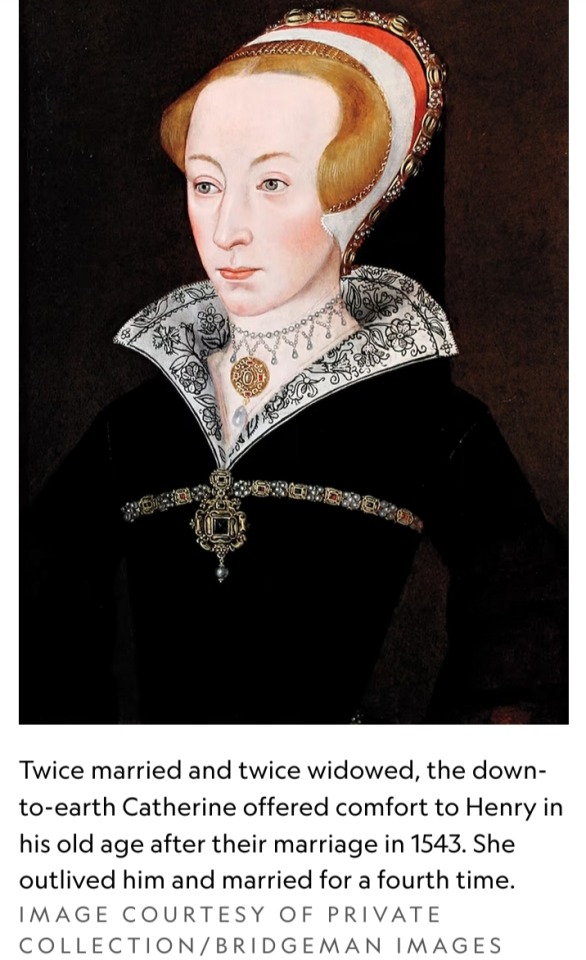
Twice married and twice widowed, the down-to-earth Catherine was reluctant at first to marry Henry. Who wouldn’t be?
She knew the fates of his previous wives, though she also knew that refusing the king could have drastic consequences.
She had caught his eye when she had been part of the household of Princess Mary, the king’s daughter.
They were married in 1543. By all reports, she was a loving, pious wife who offered comfort to Henry in his old age.
She helped Henry to reconcile with his two daughters, Mary and Elizabeth, and ensured they were educated and restored to succession.
She outlived him and married for a fourth time.
#King Henry VIII#Catherine of Aragon#Dowager Duchess of Wales#Anne Boleyn#Jane Seymour#Edward VI#Anne of Cleves#Thomas Cromwell#Hans Holbein the Younger#Thomas Cranmer#Catherine Howard#Catherine Parr#Mary Tudor#Mary I of England#Bloody Mary#Queen Elizabeth I#Queens of England#British Royal Family#King’s Beloved Sister
14 notes
·
View notes